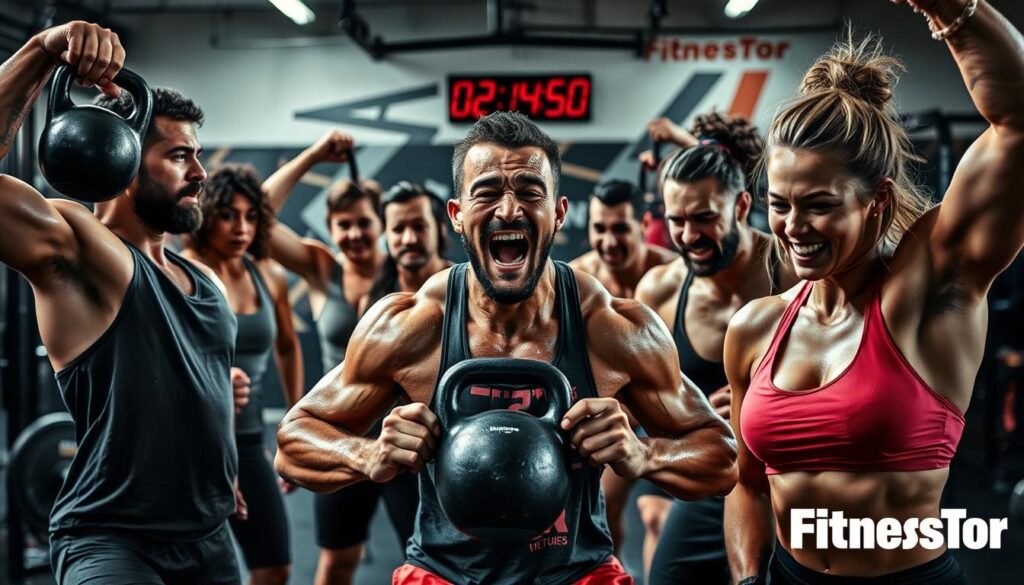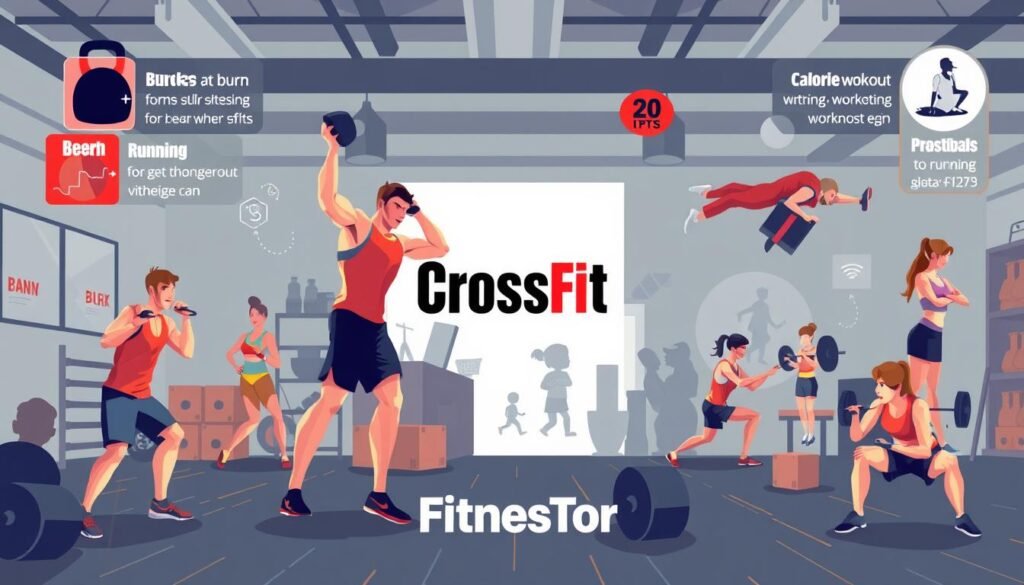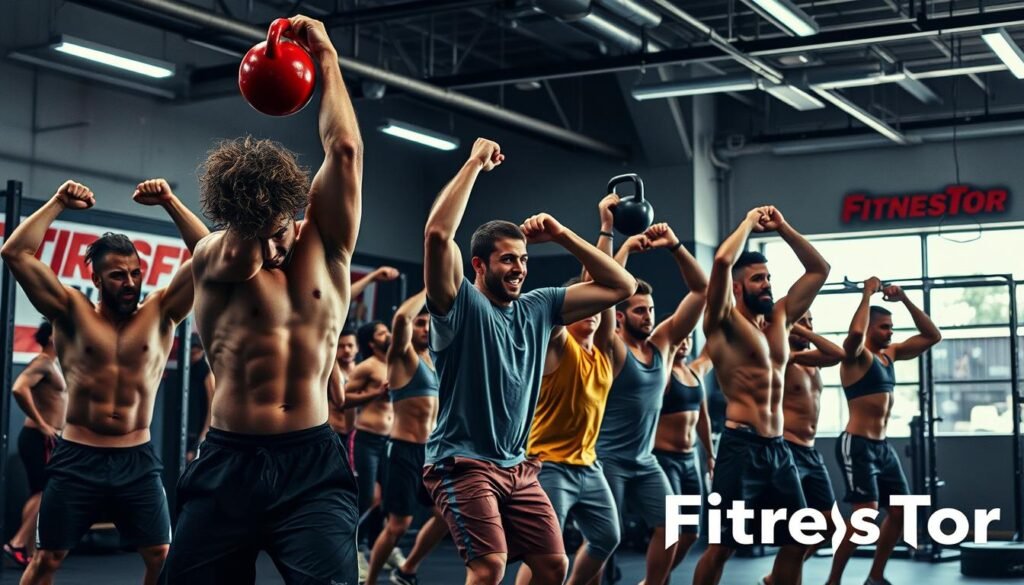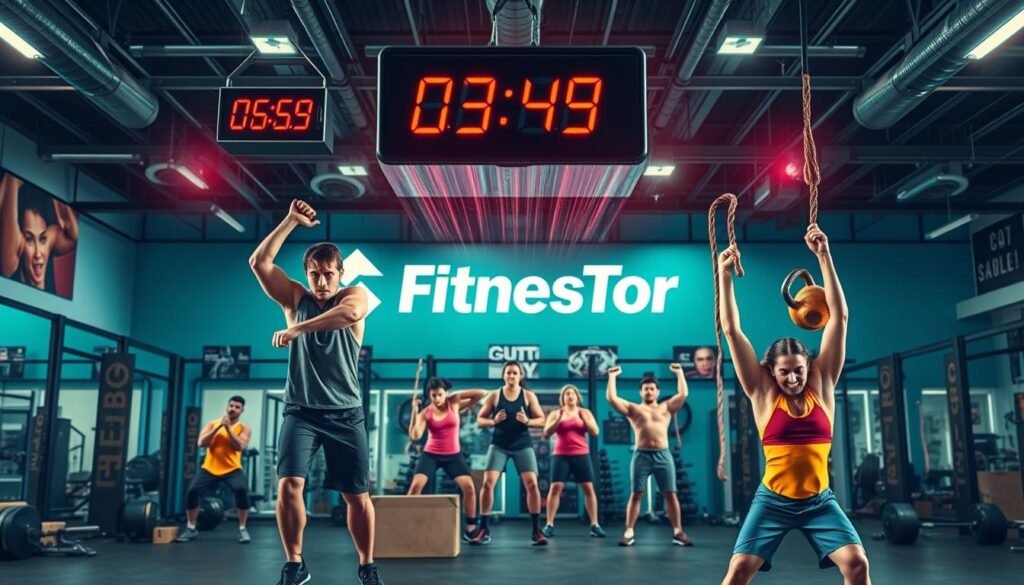Many people wonder how many calories CrossFit workouts burn. The answer depends on several things like the workout type, intensity, and the person’s weight and body type1. To figure out the caloric burn of CrossFit, we need to look at different factors. Eating the right amount of protein, about 1.6–2.2 grams per kilogram of body weight, can help with fat loss, which is key in CrossFit1.
Understanding how many calories are burned in a CrossFit workout is important. We will talk about the factors that influence this, like body weight, exercise intensity, and how fast your metabolism is.
Doing regular exercise, like CrossFit, can make your body better at using insulin, being flexible with your metabolism, and balancing hormones. These are all good for losing fat1. Mixing strength training with cardio is a great way to lose fat in a lasting way, which is common in CrossFit workouts1.
As we dive into how many calories CrossFit burns, we’ll cover what affects it. This includes your body weight, how hard and long you work out, and how fast your metabolism is.
Key Takeaways
- Understanding CrossFit calorie burn is essential for achieving fitness goals.
- Factors such as body weight and composition, exercise intensity and duration, and metabolic rate variability affect caloric burn.
- Eating 1.6–2.2 grams of protein per kilogram of body weight daily can support fat loss1.
- Regular exercise, such as CrossFit, improves insulin sensitivity, metabolic flexibility, and hormonal balance, all of which support fat loss1.
- Combining resistance training with cardiovascular exercise is effective for sustainable fat loss1.
- CrossFit workouts can be tailored to individual needs and goals, making it an effective fitness program for many people.
Understanding CrossFit Workouts
Understanding CrossFit workouts is key. They involve unique exercises and types of workouts. The calories burned and the impact on metabolism are important.
A study in The American Journal of Clinical Nutrition found that high-protein diets help with fat loss and reduce hunger2. This is important for CrossFit, which includes high-intensity workouts. These workouts can greatly affect your metabolism.
There are many types of CrossFit exercises, like strength training, gymnastics, and cardio. Combining these can burn more calories than doing one alone2. This mix makes CrossFit effective in boosting metabolism and increasing workout calories.
Nutrition is also important. Eating foods with less processing, more fiber, and protein can help reduce calorie intake2. This is good for keeping calorie expenditure in check during CrossFit.
Drinking water can also boost your metabolism by 30% for an hour2. This shows that good nutrition and hydration are key for effective workouts and metabolism.
Factors Affecting Caloric Burn
Several factors influence how many calories you burn in CrossFit. These include your body weight, how hard and long you work out, and your metabolic rate. Each person’s calorie burn is different because of these factors. For example, someone with more muscle will burn more calories, even when they’re not working out3.
Research shows that heavier people tend to burn more calories when they’re active4. Also, doing high-intensity workouts can really boost calorie burn, both during and after the exercise5. CrossFit often includes these intense workouts.
To get the most out of CrossFit, mix strength training, cardio, and HIIT into your routine. This will help you burn more calories and reach your fitness goals. Keeping track of your progress and adjusting your workouts can also help you tailor your CrossFit to your needs.
| Factor | Description | Impact on Caloric Burn |
|---|---|---|
| Body Weight and Composition | Individual’s body mass and muscle-to-fat ratio | Higher muscle mass increases caloric burn |
| Exercise Intensity and Duration | Level of physical exertion and workout length | Higher intensity and longer duration increase caloric burn |
| Metabolic Rate Variability | Individual’s resting metabolic rate and its fluctuations | Higher metabolic rate increases caloric burn at rest and during exercise |

Caloric Burn Estimates for CrossFit
Understanding the caloric burn in CrossFit is key to getting the most out of your workouts. The amount of calories burned can change a lot based on the workout type and how hard you do it. For a 150-pound person, CrossFit can burn 400 to 600 calories per hour6.
This info helps you plan your workouts and what you eat. It’s important to know the difference between strength and cardio workouts. Strength exercises, like lifting weights, burn about 200-400 calories per hour. On the other hand, cardio activities like running or jumping rope can burn 600-800 calories per hour6.
This knowledge lets you adjust your workouts to meet your calorie burn and fat loss goals. Remember, adding high-intensity interval training (HIIT) and compound exercises like deadlifts and squats can boost fat burning6. Knowing how to maximize your caloric burn can help you reach your fitness goals faster.
Comparing CrossFit to Other Workouts
When looking at CrossFit calorie burn, it’s key to compare it with other popular workouts. We’ll see how CrossFit compares to traditional weightlifting and aerobic classes. This will help us understand which burns more calories and is more effective.
CrossFit workouts use high-intensity interval training (HIIT). This method burns calories quickly, unlike moderate activities1. Traditional weightlifting builds strength and muscle. Aerobic classes, like rowing, offer a great cardio workout and burn calories7.
CrossFit vs. Traditional Weightlifting
A study in the Journal of Strength and Conditioning Research showed CrossFit burns up to 700 calories per hour. Traditional weightlifting burns about 400 calories per hour2. The big difference in calorie burn comes from CrossFit’s intense workouts.
CrossFit vs. Aerobic Classes
Rowing, a top aerobic exercise, burns up to 600 calories per hour. It’s a great choice compared to CrossFit7. But, CrossFit combines strength training and cardio. This mix can lead to more CrossFit energy expenditure.
| Workout | Caloric Burn per Hour |
|---|---|
| CrossFit | 700 calories |
| Traditional Weightlifting | 400 calories |
| Rowing | 600 calories |

Measuring Caloric Burn in CrossFit
To measure CrossFit calorie burn, the right tools are key. Heart rate monitors are a top pick, as they show heart rate and calories burned in real-time3. GPS devices and apps also track distance, pace, and calories, giving insights into workout calories1.
Getting accurate calorie tracking is vital. Heart rate monitors estimate calories burned based on heart rate8. But, remember, body weight and composition matter too. Using different tools helps CrossFitters understand their calorie burn better and tailor workouts for their goals.
Some top tools for calorie tracking include:
- Heart rate monitors
- GPS devices
- Mobile apps, such as MyFitnessPal or MapMyFitness
By adding these tools to their routine, CrossFitters can grasp their metabolism better. This knowledge helps them make smart choices about diet and exercise for the best results1.
| Tool/Device | Features | Accuracy |
|---|---|---|
| Heart Rate Monitor | Real-time heart rate data, caloric expenditure tracking | High |
| GPS Device | Distance, pace, and calorie tracking | Medium |
| Mobile App | Calorie tracking, workout logging, nutrition advice | Low-Medium |
Real-Life Experiences from CrossFitters
We’ve collected stories from CrossFitters who’ve seen big changes in their weight and fitness. Many have lost weight and improved their health, thanks to caloric burn in CrossFit9. For example, a study showed that high-intensity workouts in CrossFit can burn up to 10% more calories9.
Some CrossFitters share their tips on how to lose fat. One said, “I lost 10 pounds in weeks by doing CrossFit, eating right, and exercising regularly”10. To get similar results, setting goals and tracking your progress is key. Use tools like heart rate monitors or fitness trackers to stay on track.
Here are some key takeaways from CrossFitters’ experiences:
- Sticking to a workout and diet plan is key for losing weight and caloric burn in CrossFit goals.
- High-intensity interval training can increase CrossFit exercise calories burned by up to 10%9.
- Using tools like heart rate monitors or fitness trackers can help you stay motivated and reach your goals.

Testimonials on Caloric Burn
Many CrossFitters have seen big caloric burn in CrossFit and weight loss. Some reached their goals in just weeks. For example, one CrossFitter lost 10 pounds in weeks by combining CrossFit with a healthy diet and cardio10. These stories show how effective CrossFit can be for losing weight and CrossFit fat burning goals.
Personal Insights and Realistic Expectations
To see real caloric burn in CrossFit and weight loss, setting realistic goals is key. As one CrossFitter shared, “I lost 10 pounds in weeks by doing CrossFit, eating right, and exercising regularly”10. By sticking to a workout and nutrition plan, you can reach your weight loss and CrossFit fat burning goals.
| Workout | Caloric Burn | Duration |
|---|---|---|
| CrossFit | 400-600 calories | 20-30 minutes |
| High-Intensity Interval Training | 500-800 calories | 15-30 minutes |
| Cardio Exercises | 300-500 calories | 30-60 minutes |
Balancing Caloric Intake and Burn
To do well in CrossFit, you need to balance how much you eat and how much you burn. Good nutrition is key for energy during workouts and recovery. A balanced diet gives you the energy for CrossFit and helps with recovery.
Research shows that extreme diets can cause nutritional problems3. Instead, aim for balanced eating and small changes. This is a better way to manage weight.
Figuring out your daily calorie needs is important. This depends on your age, weight, height, and how active you are. Knowing your calorie needs helps you fuel your body right for CrossFit.
Carbs are important for energy, and complex carbs help with digestion and feeling full3. Creating a calorie deficit is key for losing fat11.
Here are some tips for balancing caloric intake and burn:
- Eat regular, balanced meals to maintain steady blood sugar levels and metabolism
- Choose complex carbohydrates over simple ones for weight management
- Avoid skipping meals, specially breakfast, to prevent slowing down metabolism
- Stay hydrated and listen to your body’s nutritional needs

By following these tips, CrossFit athletes can improve their performance and reach their fitness goals. A balanced diet and regular exercise are key for CrossFit calorie burn and health3. Adjusting your calorie intake or output is needed for fat loss, and tracking macros can help you meet specific goals11.
The Role of Rest and Recovery
Exploring CrossFit, we see rest and recovery are key for top performance and burning calories. High-intensity workouts stress our bodies. Giving them time to recover is essential to avoid injuries and stay healthy.
Studies show that enough rest and recovery boost CrossFit metabolism. This helps our bodies get better at handling tough workouts. It also means we can perform better and burn more calories. To recover, we can stretch, use foam rollers, and do self-myofascial release.
Recovery Workouts and Their Importance
Recovery workouts, like light cardio or yoga, improve blood flow and lessen muscle soreness. They help us burn calories more efficiently. By adding these workouts to our routine, we boost our performance and lower injury risks. A good recovery plan, as points out, keeps our metabolism in check, ensuring our bodies work well.
Impact of Sleep on Caloric Burn
Sleep is vital for recovery and affects calorie burn. While we sleep, our bodies fix and grow muscle, keeping our metabolism healthy. Getting 7-9 hours of sleep each night, as advises, helps our metabolism work better. This leads to better calorie burn and performance.

Popular CrossFit Workouts and Their Caloric Impact
There are many CrossFit workouts, and knowing their caloric impact is key to reaching fitness goals. The calories burned can change a lot based on the workout, how hard it is, and the person doing it. For example, high-intensity interval training (HIIT) is great for burning fat in CrossFit12.
HIIT not only burns calories while you’re doing it but also boosts your metabolism. This means you’ll keep burning calories even after you’ve stopped exercising.
A study looked at the energy used in popular CrossFit workouts. It found that these workouts can burn a lot of calories2. The amount of calories burned depends on how hard the workout is, the weight used, and the person’s fitness level. Mixing strength training with cardio is better for losing fat than doing just one2.
Workouts like “Fran” and “Cindy” are known for burning a lot of calories. They combine strength and cardio exercises. These workouts are tough, leading to a big calorie burn1.
High-intensity intervals are very effective for burning fat in CrossFit. This makes these workouts great for weight loss and better fitness.
In summary, knowing how much calories are burned in popular CrossFit workouts is important. By trying different workouts, people can burn more calories and reach their fitness goals better12.
Programming for Weight Loss with CrossFit
When it comes to weight loss with CrossFit, structuring classes is key. A well-structured CrossFit workout can significantly increase calorie burn. This leads to effective weight loss. Mixing strength training and cardio exercises boosts calorie burn and energy expenditure.
To achieve maximum burn, focus on progressive overload and tailor workouts to individual needs. Research shows aiming for a 500–700 calorie deficit daily can lead to 0.5–1 kg weight loss per week1. High-intensity interval training (HIIT) is also effective for burning calories quickly1. It’s important to monitor calorie burn and adjust workouts to meet weight loss goals.
Consistency is vital in CrossFit and weight loss. Setting measurable goals and tracking progress keeps individuals motivated. Adding activities like walking and doing household chores increases daily energy expenditure1. A well-structured CrossFit workout, balanced diet, and lifestyle optimize energy expenditure and help achieve weight loss goals.
The Science Behind CrossFit and Caloric Burn
Understanding the science behind CrossFit and caloric burn is key. The calories burned in CrossFit workouts vary based on the exercise’s intensity and type. Studies reveal that high-intensity workouts, like those in CrossFit, boost CrossFit calorie burn and enhance CrossFit metabolism2.
Excess Post-Exercise Oxygen Consumption (EPOC) plays a big role in this. EPOC is when the body uses more oxygen after intense exercise. This leads to more CrossFit calorie burn2. It’s because the body needs to refill energy stores and fix muscle damage after hard workouts.
Research shows EPOC can last hours after exercise. This means a higher CrossFit metabolism and more CrossFit calorie burn2. CrossFit is great for improving fitness and burning calories, both during and after workouts.
In summary, the science behind CrossFit and caloric burn is complex. But knowing about EPOC and high-intensity training helps maximize CrossFit workout calories and boosts fitness2.
Gender Differences in Caloric Burn
Research shows that men and women burn calories differently during exercise6. This is due to body composition and hormone levels. For example, a 150-pound person can burn 204 calories in 30 minutes of intense weight training. On the other hand, moderate-intensity weight training burns 102 calories6.
It’s important to consider individual factors when planning workouts. Women might aim for CrossFit exercise calories to lose weight. Men might focus on CrossFit fat burning to build muscle. A mix of cardio and weightlifting helps burn calories during and after exercise, improving body shape6.
Some key things to think about for gender-specific workouts include:
- Body composition: Women usually have more body fat than men, affecting calorie burn.
- Hormone levels: Hormonal differences between men and women impact their metabolic rates and energy use.
- Exercise intensity: Men and women might prefer different levels of intensity, which affects calorie burn.
By understanding these differences and tailoring workouts, individuals can maximize their Caloric burn in CrossFit and reach their fitness goals6.
Myths and Misconceptions about CrossFit
There are many myths and misconceptions about CrossFit, like how much it burns calories. We’ll clear up these myths and give you the real facts. This will help you see the benefits of CrossFit and how it affects your energy use.
Some myths say extreme diets lead to quick weight loss, or that certain foods burn fat. Others claim skipping meals helps you lose weight, or that carbs are bad. But research shows these are just myths. It’s time to debunk them for better health and fitness313.
A balanced diet and regular exercise are key for a healthy weight. CrossFit calorie burn varies with the workout’s type and intensity. By knowing the truth about CrossFit, you can make better choices for your fitness goals.
Here are some important points to remember:
- Extreme diets can cause severe nutritional deficiencies and harm your body3.
- No food can directly burn fat; it’s your diet and lifestyle that count3.
- Skipping meals can slow down your metabolism and make you eat more later3.
- Carbs are essential for energy and should be part of a balanced diet3.
- Supplements can’t replace a healthy diet and regular exercise3.
- Exercise offers many benefits, like better mental health and strength, not just weight loss13.
By understanding these myths, you can make better choices for your fitness. Always talk to a healthcare professional before starting any new diet or exercise program.
| Myth | Reality |
|---|---|
| Extreme diets guarantee quick weight loss | Extreme diets can lead to severe nutritional deficiencies and long-term harm to the body3 |
| Certain foods can burn fat | No food can directly burn fat; it’s the overall diet and lifestyle that matter3 |
| Skipping meals leads to weight loss | Skipping meals can slow down metabolism and lead to overeating later in the day3 |
Our Conclusion on CrossFit and Caloric Burn
Throughout this article, we’ve seen how CrossFit is great for burning calories and losing weight. Its high-intensity workouts engage many muscle groups, leading to a lot of calorie burn during and after4. Studies also show that High-Intensity Interval Training (HIIT), a key part of CrossFit, burns more fat in less time than regular cardio12.
Final Thoughts on Effectiveness
The number of calories burned in CrossFit varies based on your weight, how hard you work, and your metabolism1. But, most agree that CrossFit is very effective for burning calories and helping with weight loss. It combines strength training, intense cardio, and functional movements in a way that challenges your body in new and tough ways.
Encouragement to Start or Continue CrossFit
If you want to burn more calories and reach your fitness goals, try CrossFit. It’s great for anyone, whether you’re experienced or just starting out. The calorie and fat-burning benefits of CrossFit are amazing for managing weight. So, get ready to challenge yourself, push your limits, and see the pounds disappear with CrossFit1.
FAQ
What makes CrossFit unique?
What types of exercises are included in a CrossFit workout?
What factors affect the number of calories burned during a CrossFit workout?
How many calories can I expect to burn during a CrossFit workout?
How does the caloric burn of CrossFit compare to other workouts?
What tools and devices can I use to track my caloric burn during CrossFit?
How can I balance my caloric intake and burn for optimal performance in CrossFit?
What are some popular CrossFit workouts and how do they impact caloric burn?
How can I structure my CrossFit training for weight loss?
Are there any gender differences in caloric burn during CrossFit workouts?
What are some common myths or misconceptions about the caloric burn in CrossFit?
FitnesTor is a cutting-edge fitness company dedicated to helping individuals achieve their weight loss and fitness goals in the most effective and sustainable way. At FitnesTor, we believe that losing weight isn’t just about shedding pounds—it’s about building healthier habits, gaining confidence, and transforming your life from the inside out.


